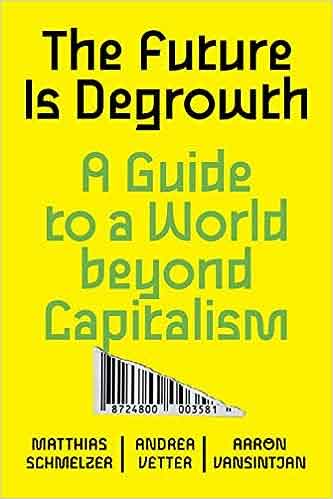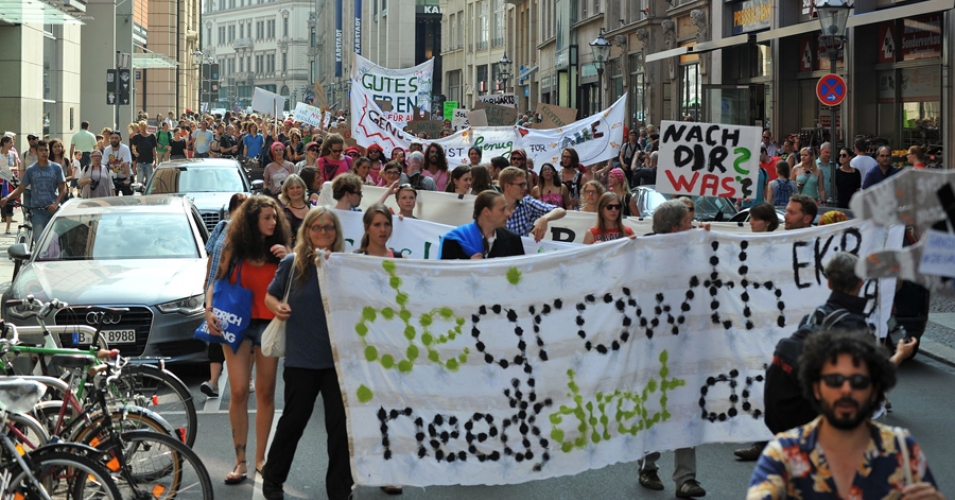
In the 1970s, the emphasis was on resource limits. The French term décroissance (later translated into English as degrowth) was used for the first time by French intellectual André Gorz. In his book Ecology and Freedom, published in 1977, he wrote that “lack of realism consists in imagining that economic growth can still bring about increased human welfare, and indeed that it is still physically possible.” As the authors of the book “Degrowth: A Vocabulary for a New Era” explain, Gorz was inspired by the work of the intellectual pioneer of ecological economics Nicholas Georgescu-Roegen, who argued that all natural resources are irreversibly degraded when put to use in economic activity because of the entropy law. The discipline of ecological economics later went on to theorize that the economic system is embedded in the ecological system.
A brief history of degrowth
At the turn of the millennium, the driving force of the degrowth narrative became the criticism of the idea of development and infinite economic growth. Public debate on the oxymoronic nature of the term ‘sustainable development’ was sparked by the influential books of French economic historian Serge Latouche. His critique aims to counteract the hegemony in the public debate of infinite economic growth as a one-way future for the whole of humanity. It is the automatic association of ‘growth’ with ‘improvement’ that this perspective sought to dismantle through the term ‘degrowth’. Today, the rhetoric in mass media and politics frequently reinforces the public’s association of growth with an improvement in well-being, despite mounting evidence that in developed countries this is no longer the case.
The emergence of degrowth as an international research area can be traced back to the first international conference organized in Paris in 2008 by academic collective Research & Degrowth, based at the Autonomous University of Barcelona. At this conference, degrowth was defined as a “voluntary transition towards a just, participatory, and ecologically sustainable society,” and proposed as the process that the wealthiest countries should go through in order to achieve a “right-sizing” of both national economies and the global economy. Another five international conferences on degrowth were organized in the period 2010-2016, thus spreading the degrowth movement to several countries around the world. These conferences have also created a crucial bridge between scientists and social activists who are progressively using the term ‘degrowth’ as a rallying cry for their campaigns against neoliberalism and the privatization of common resources. As a result, degrowth has now become a confluence point where streams of critical ideas and political action converge.
What do we mean by degrowth?
Degrowth means primarily the abolition of economic growth as a social objective. This implies a new direction for society, one in which societies will use fewer natural resources and will organize and live differently from today. Ecological economists define degrowth as an equitable downscaling of production and consumption that will reduce societies’ throughput of energy and raw materials. However, the shift should not only entail a smaller social metabolism, but more importantly a society with a metabolism that has a different structure and serves new functions.
The costs of growth include bad psychological health, long working hours, congestion, and pollution. GDP may still increase, but in most developed economies welfare indicators have stagnated since the 1970s. Above a certain level, further growth does not increase happiness. This is because once basic material needs are satisfied, extra individual income is devoted increasingly to positional goods. It is, therefore, not growth that improves social well-being in advanced societies, but income equality.
Furthermore, infinite growth appears to be totally at odds with our scientific knowledge of the finite resource base and the fragile ecology on which we depend for survival. While the global economy is almost five times the size it was half a century ago, it has already been accompanied by the degradation of an estimated 60% of the world’s ecosystems. With continuous global growth, most planetary boundarieswill sooner or later be surpassed, particularly the carbon concentration in the atmosphere that would cause catastrophic climate change. The economy could in theory be decarbonized with the advancement of cleaner technologies and dematerialized with a shift to services. However, with 2-3% global growth per year, the degree of decarbonization and dematerialization required is next to impossible, as the continuation of this article will seek to show.
Is sustainable development just a pipe dream?
Degrowth theory questions the linchpin of sustainable development: decoupling. By this term environmental economists define the trend by which economic output progressively uses less energy and raw materials because of increases in efficiency. According to this theory, there is no irreconcilable clash between economic growth and environmental preservation: you can have your cake and eat it too.
There is, however, a distinction between relative and absolute decoupling. Relative decoupling refers to a decline in the ecological intensity per unit of economic output. However, the use of energy and raw materials does not decline in absolute terms. Impacts may still increase, but do so at a slower pace than growth in GDP. This is an attainable goal as the capitalist system is good at increasing efficiency in production processes because resource inputs represent a cost to producers. For example, the amount of primary energy needed to produce each unit of the world’s economic output has fallen more or less continuously over most of the last half century. The global energy intensity of GDP is now 33% lower than it was in 1970. The same is true of material intensities more generally.
On the contrary, absolute decoupling is brought about when ecological resource use declines in absolute terms over time. This latter situation is essential if economic activity is to remain within ecological limits. Evidence of absolute decoupling happening anywhere in the world is hard to find. In only a couple of countries can we observe a stabilization in resource requirements since the late 1980s. Supposedly, this would point in the direction that absolute decoupling is feasible and that certain advanced economies can attain it. However, the problem is that it’s difficult to assess all the resources embedded in traded goods. In fact, developed economies tend to move progressively away from domestic manufacturing and, unless the demand for consumer goods also declines, more and more goods are imported from abroad. The result is that a country’s greenhouse gas emissions can decline over time while the carbon footprint of its inhabitants increases because of the carbon embedded in imported goods.
Ultimately, in any case, what counts most in terms of global limits is worldwide statistics. Both climate change and resource scarcity are essentially global issues, which necessarily means looking at worldwide trends. The world GDP has risen faster than carbon dioxide emissions over the last eighteen years, yet there is no absolute decoupling happening. If we were to sketch this on a graph, we would see the trend of global GDP rising at a faster rate than global greenhouse gas emissions do, but nonetheless they are both on the rise. In order to meet the IPCC’s 450 ppm stabilization target and avoid the worst climate change scenarios, absolute reductions in global carbon emissions of 50-85% must be met by 2050.
The lack of evidence for absolute decoupling is the Achilles’ heel of the rhetoric of sustainable development, and as such forms the starting point for the degrowth critique.
Is a degrowth economy possible?
If there is no consistent vision of an economy founded on consumption growth that delivers absolute decoupling, then a different way of ensuring ecological stability and maintaining employment is essential. A different kind of economic structure is needed for an ecologically constrained world. In economics, a new ecological macroeconomics without growth is emerging, building on Herman Daly’s “steady-state economy”, which could evolve into a new economic paradigm.
According to the influential report “Prosperity Without Growth” by economist Tim Jackson, modern economies are built explicitly around consumption growth. Politicians and economists may differ in their prescriptions for kick-starting growth in the event of a recession, but all of them assume a return to high street spending is what we are after. Apart from anything else, in the conventional view, structural stability relies on it. And though Keynes’ macroeconomics was largely concerned with the conditions of prudent growth, he also foresaw a time when the “economic problem” would be solved, and “we [would] prefer to devote our further energies to non-economic purposes”.
All the more strange, then, that virtually no attempt has been made to develop an economic model that doesn’t rely on long-term growth. We have no model for how common macroeconomic variables behave when capital doesn’t accumulate. Nor do our models properly account for the dependency of macroeconomic variables on ecological variables such as resource use, reserves, emissions, and ecological integrity.
One potential avenue of exploration is to attempt a stabilisation of economic output by altering the role or relative importance of key variables (such as consumption, investment, public spending and so on) within the basic macroeconomic model. Is it possible to configure the conventional macroeconomic variables in such a way as to reduce the imperative for growth, and yet maintain economic stability?
The most notable research conducted in this direction is a study carried out by the economist Peter Victor. Based on this study, the most influential factors in the transition to a sustainable economy are changes to investment and the structure of the labour market. In the macroeconomic scenario that Victor developed for Canada as a case study, net business investment is reduced, accompanied by a shift in investment from private to public goods, implemented through changes in taxation and public spending. The labour force can be stabilised, partly through demographic change and partly through policies aimed at stabilising the overall population.
Labour productivity is assumed to increase, which normally leads to a reduction in available work. However, in this macroeconomic model, unemployment is averted by sharing the work more equally across the available workforce. Consequently, the total and the average number of working hours are reduced. Reducing the working week is the simplest and most often cited structural solution to the challenge of maintaining full employment with non-increasing output. But there are some other more radical suggestions for reorganising, such as the introduction of a universal basic income.
The traditional function of investment is framed around labour productivity, whereas this role is likely to diminish in importance in a degrowth economy. Innovation will still be vital, but it will need to be targeted more carefully towards sustainability goals. Specifically, investments will need to focus on resource productivity, renewable energy, clean technology, green business, climate adaptation and ecosystem maintenance and protection. And the public sector, far from being a “distortion” of the free market, has an absolutely crucial role to play in the transition.
What Victor’s study demonstrates is that there may be more room than commonly supposed—even within the conventional framework—to stabilise economic output. The fundamental macroeconomic variables will still pertain. People will still spend and they will still save. Enterprise will still produce goods and services. Government will still raise revenues and spend them in the public interest. Both the private and public sector will both still invest in stocks of physical, human and social capital. But new macroeconomic variables will need to be brought explicitly into play. These will almost certainly include variables to reflect the energy and resource dependency of the economy as well as the value of environmental services or stocks of natural capital.
Policy proposals for degrowth
According to a recent study, degrowth proposals published in peer-reviewed journals align with three broad goals. The first goal is to reduce the environmental impact of human activities through the following proposals: reduce material and energy consumption; encourage or create incentives for local production and consumption; and promote changes in consumption patterns. The second goal is to redistribute wealth both within and between countries through the following proposals: promote community currencies and alternative credit institutions; promote a fair distribution of resources through redistributive policies of income; promote work-sharing and create a citizen’s income. The third goal is to foster the transition from a materialistic to a convivial and participatory society by promoting downshifted lifestyles and by exploring the value of unpaid activity.
Despite the grassroots origins of degrowth, the majority of these proposals follow a top-down approach and have a national geographical focus. Many proposals require direct control by governments through measures such as caps, taxes, and regulations, suggesting the need for a high level of state intervention to pursue a degrowth transition. This contradicts the discourse of many degrowth proponents, which is usually focused on the need for a voluntary and democratic downshift, and thus an intrinsic pursuit of more public space so that civil society can be an active agent of change. However, the categorisation of proposals into top-down and bottom-up categories may be controversial. In fact, it is important to note that some proposals classified as top-down may have the goal of indirectly driving bottom-up action. An example is the proposal to reduce working hours: although many people might prefer to work fewer hours, this can only happen if institutions are reformed to give them this choice.
The only remaining question is whether there is anybody listening to these proposals in the political sphere. In the UK, the All-Party Parliamentary Group (APPG) on Limits to Growth is to provide a new platform for cross-party dialogue on economic growth in a time of environmental and social transition. Among its other activities, the AAPG organizes debates at the House of Commons, such as a recent one entitled “The end of growth?”, which was moderated by Tim Jackson and Green Party co-leader Caroline Lucas. The hundred tickets made available to listen to the debate sold out in a few hours.
And as Federico Demaria, a researcher in the academic collective Research & Degrowth, pointed out in a recent article, degrowth has certainly already had an impact as some politicians, like Nicolas Sarkozy and Matteo Renzi, felt at least the need to dismiss it. Widely debated in the media, at the moment it receives the support of at least three contemporary European political leaders, including Juan Carlos Monedero of Podemos in Spain, Beppe Grillo of Movimento 5 Stelle in Italy and Benoit Hamon, the candidate for the French Parti Socialiste in the 2017 presidential elections.
The degrowth transition to avoid runaway climate change and ecosystem degradation will not be easy to achieve. Individuals are too exposed to social signals and status competition. Businesses operate under market conditions. A transition from narrow self-interest to social behaviours, or from relentless novelty to a considered conservation of things that matter, can only proceed through changes in the underlying economic structure. However, as Naomi Klein explains in “This Changes Everything”, the conservative movement in the US has put climate denial at the centre of its identity more than progressives around the world have been able to rally consensus around the need for the energy transition and a new economic paradigm.
As the ecological economist Giorgos Kallis argues, it can be difficult for parties on the left to make degrowth their banner because of the difficulties of confronting an entrenched common sense. That said, it is at least expected of genuine progressive parties to have ideas in place on how to ensure society’s prosperity and equality without undermining the ecological stability of our planet.
Riccardo Mastini holds a master’s degree in Human Geography from Lund University in Sweden and is currently working as a consultant on sustainability projects for UNEP, WWF, and national governments in several developing countries.
Originally published by OpenDemocracy
This article is published under a Creative Commons Attribution-NonCommercial 4.0 International licence.

















































